Introduction: A Brief Overview of the Social Situation in the 1970s
The period of the 1970s was associated in the United States with substantial social and political reform, in particular with the introduction of truly equal rights and improvement of minorities’ image in the social consciousness and the transition of the American politics from the military to the more peaceful political course (Binkley, 2007, p.54; Carlisle & Golson, 2007, p.18). The present paper is intended to discuss the relationship between contemporary ad design and promotion of social change.
First of all, it is necessary to delineate the key social, political and cultural tendencies for which the 1970s in America were actually famous. First of all, the 1960s legacy of equality and anti-war movements was maintained and enriched in the 1970s, so that racial minorities, for instance, received an opportunity called affirmative action, which encouraged employers to promote nom-white workers and gave minority students expanded access to education (Carroll, 1990, p.49; Szulz, 1974, p. 82). Furthermore, women were granted additional rights to control childbirth; moreover, the 1960s social struggle of women for equal treatment in occupational settings continued. Moreover, the perceptions of women’s physical identity were reconsidered: “The recognition that sex –and often sex alone – determined one’s identity came as a traumatic truth to American women – not only because the idea contradicted timeworn rhetoric about social equality“ (Carroll, 1990, p.24). Furthermore, in 1975, the 16-year Vietnam War came to its end, partly owing to the activism of the grassroots groups and to great extent due to the fact that the economy was drained and the society – exhausted – by the military conflict which seemed to bring no perceivable benefit. The new political challenges on which the government focused was balancing the growth of nuclear armament with the social protests against mass destruction weapons and the popularization of environment protection groups (Tropman, 1998, p.59). In the 1970s, the postwar baby boomers were growing, maturing into well-educated young people who had a broad range of professional opportunities, as opposed to their parents, as the 1970s young adults were 30% more likely to get at least college education (Carlisle & Golson, 2007, p.64). Thus, the children, born in the postwar years, won their economic independence in the 1970s, and the main part of the popular culture was intended mainly for the numerous middle-class young adults aged 20-25. Thus, it enjoyed a diversification in terms of styles, genres, e.g., there appeared a variety of directions in music and fashion (Tropman, 1998, p.112; Rajvanshi, 2001, p.19). At the same time, these young people did not rash to create a traditional nuclear family, as their [parents did at age 20-25; moreover, the economic and social liberation of women to certain degree “undermined” family values: “A 1978 Gallup survey of teenage attitudes toward divorce found that two-thirds of the nation’s youth endorsed separation on grounds of incompatibility” (Carroll, 1990, p.278)
Reflections on the Social Change in Advertising
The design of the contemporary advertisements to great extent reflected the liberation of gender minorities. For instance, the interesting ad spread by Republic Steel, one of the largest American steel producers, talks about the importance of women’s participation in labour market. The image clearly demonstrates that the company willingly hires women of all national and cultural backgrounds, regardless of their lifestyles and hobbies, as one of the women on the picture is definitely interested in sports (a racer or horse rider), the second one probably has more traditionalist views due to her modest dressing and hairstyle, whereas the third one is a representative of the middle-class African American population, which was growing in the 1970s as a result of the governmentally endorsed equality in educational and occupational areas. All these women are depicted as well-educated and career-oriented employees, as logically, there are no males or “breadwinners” present, so these three women provide for themselves on their own, and their apparel clearly demonstrates that they can afford fashionable clothing. At the same time, these women are relatively young, probably aged below 30, so the design of this ad is aimed first and foremost at “baby boomers” who were the first to make use of and capitalize on the new educational and professional opportunities (Binkley, 2007, p.128).
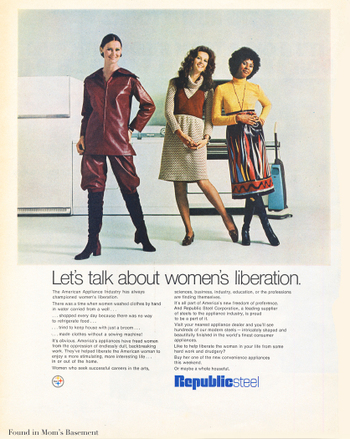
Promotion of Social and Cultural Change Through Advertising
The two ads promoting Kool and Trust cigarettes are also quite illustrative in terms of contemporary social change. The Kool commercial shows a young woman, probably from the generation of baby boomers, who rides a bike and informs the audience that Kool is a choice of active women. Whereas female images were used in cigarette advertising before the 1970s, the heroine of the present image is to great extent “masculinized”, as her hobby is obviously “manly” and she is positioned as a smoker. As this ad provides comprehensive information including her age, social class (middle class), possible occupation (white-collar employee), it suggests that all women lead dynamic lifestyles, do sports and engage with “male” activities without any prejudices and supervision, as they are young, beautiful, independent, self-confident and definitely can afford “being themselves”. Similarly, the main character of the Trust commercial is obviously a professional athlete, who is concerned about her health and thus selects “light” and low-nicotine cigarettes. This woman is smoking on the tennis court, probably having her rest after a difficult tournament. From the perspective of design, this advertisement conveys a powerful message, which is not related to encouraging females to consume nicotine, it rather motivates females with sports ambitions to forget about their fears of discrimination and become professional athletes. It needs to be noted that systemic discrimination on the basis of gender in professional sports was actually mitigated by the 1970s when women began to make careers in previously “men-only” areas like basketball and tennis (Carlisle & Golson, 2007, p.154). The hero of the Trust ad is a prominent example of a successful sports star who enjoyed fulfilling professional development and thus might have become a role model for a number of young and ambitious female athletes.


As the traditional patterns of female beauty in advertising and ad design were reviewed in connection with the spread of feminism, one of the prominent ads promoting “natural appearance” as beautiful is the Kellogg’s commercial. As one can see, the image shows a woman, who cannot be categorized as attractive or even cute; moreover, she is dressed very modestly and has very little makeup on her face. However, the photographer decided to take a close-up of the heroine and the designer’s decision was revealing each trait of her face. The image of non-canonical women points to the existing social discourse about the transformation of the beauty canon and reconsideration of women’s physical identity. The emphasis on the bodily characteristics, maintained in the 1950s-1960s through displaying glamorous models with perfect hairstyles and notable makeup was replaced with propagation of “the natural” look, so the appearance of the ad star was closer to the image of the average American female.
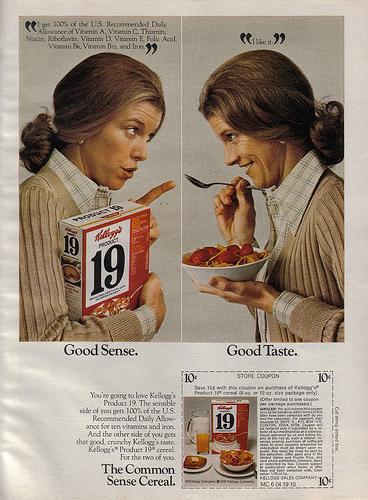
As noted above, the design of advertising in the 1970s to great extent promoted social change, which consisted in women’s paid employment and career success in “white-collar” positions and professional sports. In addition, due to the fact that the recurrent theme of the 1970s mass communication was concerns about environment and biodiversity preservation, a number of ads highlighted the necessity of using electricity and gas-saving technologies at home. For instance, the commercial, issued by the American Gas Association, suggests that all homeowners use gas air conditioning in order to save operation costs. Moreover, the new technology naturally contributed to optimization of natural gas distribution across the country, which, in turn, allowed maintaining ecological stability in certain regions.
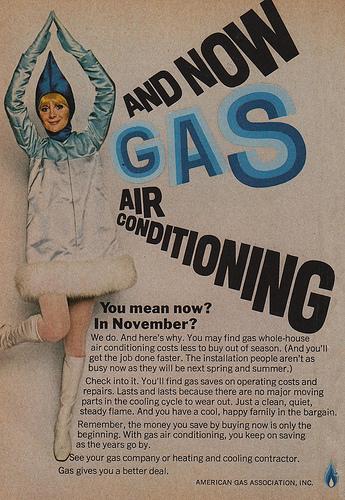
Another important mission of the contemporary mass communication was normalization of the image of racial and ethnic minorities. For instance, the Breck Girl Shampoo ad portrays a Latino (or Mexican American) model. Due to the fact that her image is used in relationship with beauty, one can assume that this commercial underlies a powerful message stating that minority women are really admirable, even if compared with the canonic fair-haired and blue-eyed American. The designer’s decision was using a close-up of the woman’s face, and one can assume that Latino women are friendly (the heroine is smiling openly), polite and well-mannered (the heroine is dressed according to the existing code) and not necessarily belong to the working class, as the face of the main character is placed on the background, which shows various scenes from the life of the Victorian top class. Thus, the Breck Girl picture can be viewed as a call for the elimination of discrimination against and stereotypes about Latino women, traditionally perceived as aggressive and narrow-minded (Tropman, 1998, p. 92).
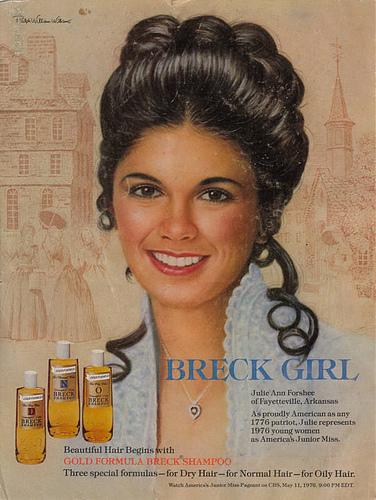
The concepts chosen for Burger Beer and Hudepohl Beer promotion are even more unexpected, as both of them show African Americans, who seemed to fit into the 1970s standards of pleasant appearance as opposed to those of the 1950s and 1960s. The burger ad is monochrome and contains a close-up photograph of an African American woman, and the slogan on the top of the picture writes: “Burger is Beautiful”. The Hudepohl ad shows a scene from the life of an African American couple, both are drinking beer before going to the club. As both man and woman are drawn on the foreground, the overall impression about the ad is positive, as it creates a sense of intimacy, i.e. it seems like the two are sharing secrets about their relationships. Both images endorse social change by encouraging the audience to alter their views on African Americans and develop the belief that they are not different from the ”majority Americans”, as the representatives of this ethnic group are pleasant, sincere and lead absolutely the same lifestyle as the others, so there is no reason to exclude them from the society.
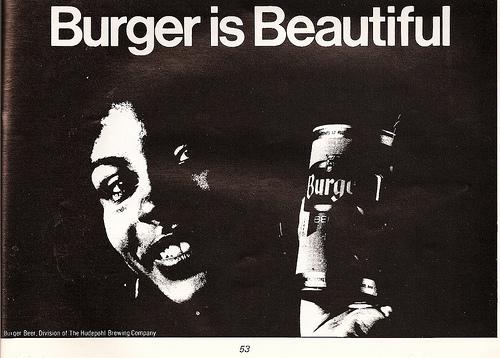
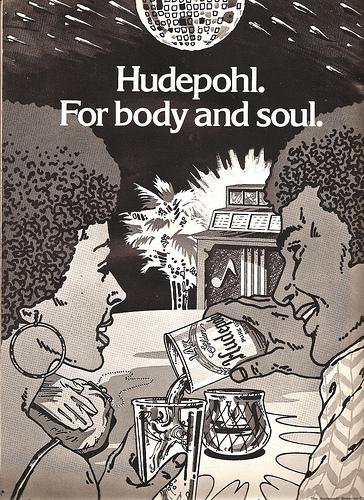
Finally, it needs to be admitted that the advertising of the 1970s actually contributed to the neglect of the traditional family values, which was statistically measured by the end of the decade (Carroll, 1990, p. 280). In particular, most advertising campaigns implied depicting the free relationships of young people and targeted their products for individual citizens rather than for “family use” (Binkley, 2007, p.43). For instance, such products as Kellogg’s Crisps, intended for all audiences, are advertised through using the images of a single woman or a couple, rather than the regular patterns of “family routines”, “family pastime” and “family breakfast”. Therefore, even the producers of “family use” commodities tended to promote individualism and free relationships rather than nuclear households. As one can conclude from the above-described ads, the centre of the visualized concept in advertising is either a single person or a dating couple, even the Armstrong Vinyl Ceilings commercial, which underlines comfort and domestic atmosphere, employs the image of a single girl, who obviously enjoys living in such a “hi-tech” apartment.
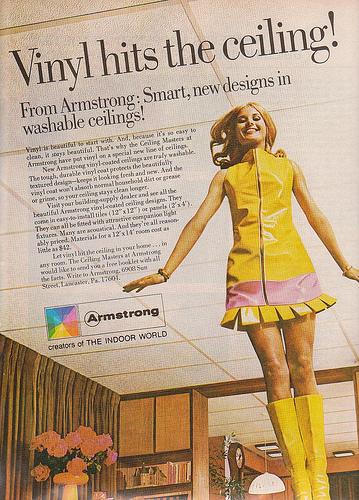
Conclusion
To sum up, the social change of the 1970s was to a certain degree crafted by the contemporary ads, which promoted accepting and non-discriminatory attitudes towards racial minorities, women’s career determination and professional growth as well as individualism, which sometimes turned into “sound egoism” of being oneself at any price.
References
Carroll, P. 1990. It seemed like nothing happened: America in the 1970s. Rutgers University Press.
Binkley, S. 2007. Getting loose: lifestyle consumption in the 1970s. Duke University Press.
Carlisle, R. and Golson, G. 2007. America in Revolt During the 1960s and 1970s. ABC-CLIO.
Tropman, J. 1998. Does America hate the poor?: the other American dilemma: lessons for the 21st century from the 1960s and the 1970s. Greenwood Publishing Group.
Szulz, T. 1974. Innocents at home: America in the 1970s. Viking Press.
Rajvanshi, A. 2001. America –An Indian Student’s Journey. NARI Press.